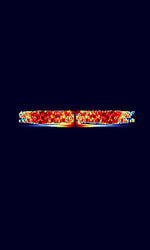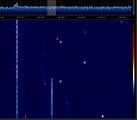Distress Radiobeacon (Digital)
 | |
|---|---|
| Frequencies | 406 MHz |
| Frequency Range | 406 MHz - 406 MHz |
| Mode | NFM |
| Modulation | PSK |
| ACF | — |
| Emission Designator | — |
| Bandwidth | 1.4 kHz |
| Location | Worldwide |
| Short Description | Digital Distress Radiobeacons (EPIRB's, PLB's and ELT's) are emergency radio beacons used for search and rescue operations to locate a vessel, plane, or person in distress. |
| I/Q Raw Recording | Download file |
| Audio Sample | |
Digital Beacon | Analog Beacon
Digital Distress Radiobeacons (EPIRB's, PLB's and ELT's) are emergency radio beacons used for search and rescue operations to locate a vessel, plane, or person in distress. The digital form of distress radiobeacons are far improved by the ability to send GPS data, and the accuracy of alerts.
Distress Radiobeacons come in three subcategories, PLB (Personal Locator Beacon), ELT (Emergency Locator Transmitter) or EPIRB (Emergency Position-Indicating Radio Beacon). EPIRB is for marine use, ELT is for aviation use, and PLB is for personal usage in areas where normal emergency services are not available.
The Digital (406 MHzMegaHertz (MHz) 10^6 Hz) Radiobeacon uses BPSKBinary Phase-Shift Keying (1 bit per symbol) modulation at 400bps to transmit important data such as location (if GPS-enabled), registered user, serial number, national location protocol, and additional data programmed into the radiobeacon. These transmissions are monitored on the 406 MHzMegaHertz (MHz) 10^6 Hz frequency band by satellites. Analog radiobeacons are no longer monitored by satellites as of February 2009.
Digital radiobeacons are replacing the older analog radiobeacons that operate at 121.5 MHzMegaHertz (MHz) 10^6 Hz and 243 MHzMegaHertz (MHz) 10^6 Hz. Many digital radiobeacons are also equipped with a 121.5 MHzMegaHertz (MHz) 10^6 Hz homing signal that's essentially the Analog siren used on old analog radiobeacons. This homing signal continuously transmits and may be interrupted when the 406 MHzMegaHertz (MHz) 10^6 Hz data burst is transmitted to conserve energy. This gives new digital radiobeacons both analog radio-finding capability as well as digital GPS-based location capability.
Samples[edit]
USBUpper Side Band Modulation (Radio, referring to reception and modulation mode)Universal Serial Bus (Computer, referring to USB Ports and cables):
NFMNarrowband Frequency Modulation:
Decoding Tutorials[edit]
Decoding Software[edit]
- Hobby Level Software
Video Examples[edit]
Additional Links[edit]
- Wikipedia Distress Radiobeacon
- United States Coast Guard Information on EPIRB's
- FAA TSO-C126 406 MHz EMERGENCY LOCATOR TRANSMITTER

